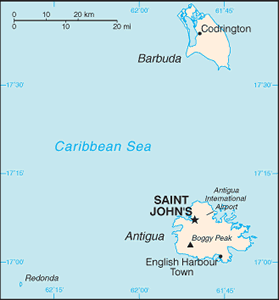The Geography of Antigua and Barbuda
The Geography of Antigua and Barbuda
Antiguan, Barbudan Geography
Location: Caribbean, islands between the Caribbean Sea and the North Atlantic Ocean, east-southeast of Puerto Rico
Geographic coordinates: 17 03 N, 61 48 W
Map references: Central America and the Caribbean
Area: total: 442.6 sq km (Antigua 280 sq km; Barbuda 161 sq km) land: 442.6 sq km water: 0 sq km note: includes Redonda, 1.6 sq km
Area - comparative: 2.5 times the size of Washington, DC
Land boundaries: 0 km
Coastline: 153 km
Maritime claims: territorial sea: 12 nm contiguous zone: 24 nm exclusive economic zone: 200 nm continental shelf: 200 nm or to the edge of the continental margin
Climate: tropical maritime; little seasonal temperature variation
Terrain: mostly low-lying limestone and coral islands, with some higher volcanic areas
Elevation extremes: lowest point: Caribbean Sea 0 m highest point: Boggy Peak 402 m
Natural resources: NEGL; pleasant climate fosters tourism
Land use: arable land: 18.18% permanent crops: 4.55% other: 77.27% (2005)
Irrigated land: NA
Natural hazards: hurricanes and tropical storms (July to October); periodic droughts
Environment - current issues: water management - a major concern because of limited natural fresh water resources - is further hampered by the clearing of trees to increase crop production, causing rainfall to run off quickly
Environment - international agreements: party to: Biodiversity, Climate Change, Climate Change-Kyoto Protocol, Desertification, Endangered Species, Environmental Modification, Hazardous Wastes, Law of the Sea, Marine Dumping, Ozone Layer Protection, Ship Pollution, Wetlands, Whaling signed, but not ratified: none of the selected agreements
Geography - note: Antigua has a deeply indented shoreline with many natural harbors and beaches; Barbuda has a large western harbor


